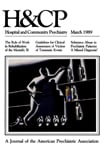Missed Diagnosis of Substance Abuse in Psychiatric Patients
Abstract
Like many other studies, our study found that drug users cannot be differentiated from nonusems on the basis of age, sex, or diagnosis. Another more interesting finding is that the drug-related diagnosis is often missed.
About 75 percent of the patients in our sample met the critena for diagnosis of drug abuse or drug addiction even after excluding occasional use and the possible abuse of prescription drugs such as antiparkinsonian preparations and other over-the-counter drugs. The drug abuse was detected only on the third level of screening subsequent to evaluations in the emergency rooms of university hospitals and after a complete state hospital evaluation. Therefore our results suggest that drug abuse and addiction are more common in psychotic patients than generally diagnosed and are often missed. Use of multiple drugs may complicate the clinical picture, leading to difficulties in diagnosis and management.
We believe that drug abuse and drug addiction were not detected in the emergency rooms and in the state mental hospital because of the acute psychotic state of patients at that time, which mendened them incapable of providing a proper history. Routine toxicological screening may not be useful unless it is conducted at the earliest possible time after drug intake. While a positive result is often diagnostic, a negative finding on toxicological screening should not rule out drug use.
Our success in detecting drug use can be related to a number of factors. We obtained detailed histories and conducted the physical examination at a time when the patients were able to fully cooperate. In addition, the patients' drug history was obtained methodically using DSM-III criteria, and patients were asked probing questions from the Diagnostic Interview Schedule instead of being asked whether they took any drugs. Based on our results, we believe that the custom of cornpleting the history, physical examination, and diagnosis within 24 hours of admission needs a second look. We recommend a provisional diagnosis initially and a follow-up evaluation utilizing the patient's complete history only when the patient is able to cooperate fully.
Diagnosis of drug abuse in psychiatnic patients is not an exercise in futility. The presenting symptoms of florid psychosis may not be related to the patient's underlying psychosis, and hence appropniate diagnosis of drug-related psychopathology may change the prognosis. Drugs also may have an impact on nutrition and on the physical health of the patient. Clinicians should bear in mind the possibility that psychotic patients may be taking street drugs. It is important to obtain a thorough history when florid psychosis has resolved.
Access content
To read the fulltext, please use one of the options below to sign in or purchase access.- Personal login
- Institutional Login
- Sign in via OpenAthens
- Register for access
-
Please login/register if you wish to pair your device and check access availability.
Not a subscriber?
PsychiatryOnline subscription options offer access to the DSM-5 library, books, journals, CME, and patient resources. This all-in-one virtual library provides psychiatrists and mental health professionals with key resources for diagnosis, treatment, research, and professional development.
Need more help? PsychiatryOnline Customer Service may be reached by emailing [email protected] or by calling 800-368-5777 (in the U.S.) or 703-907-7322 (outside the U.S.).



